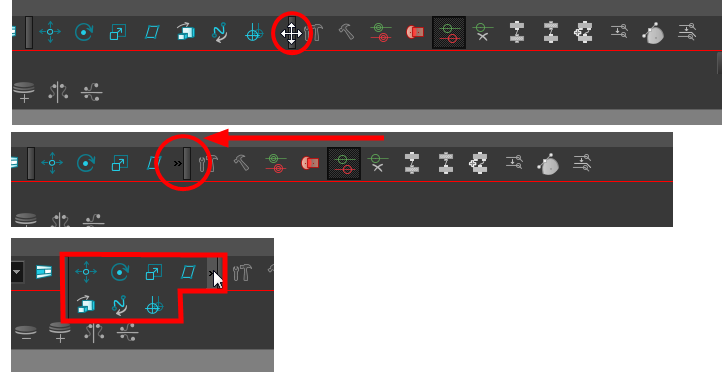Managing the Toolbars
Harmony contains toolbars which, by default, are located at the top of the interface. Some of the views also have their own toolbars which you can move around. You can reposition the toolbars to suit your work style or hide unused ones.
You can display or hide toolbars using the menus. The Toolbar menu only contains the View toolbars of the views that are displayed in the workspace. As you show or hide views in your workspace, the Toolbar menu updates.
The top toolbars can also be displayed directly in a view. Only one instance of each toolbar can be displayed. If a toolbar is already displayed in the top area and you decide to display it in a view, the selected toolbar will move from the top area to the view.
The toolbars in any of the views can be customized with your favourite tools. Using the Toolbar Manager dialog box, you can organize different toolbars to suit your working style.
If you prefer to have all your tools visible in the Tools toolbar, the Flat Tool Toolbar option allows you to expand the toolbar so there are no nested toolsets in the toolbar. When you set this option, you will need to close Harmony and restart it for the new interface to be displayed. A default set of tools will appear in the toolbar. However, you can customize the toolbar with the tools that more closely fit your work pattern.


If the default toolbar does not contain the tools you require, you can customize the toolbar.
Once you are displaying the flat toolbars, you can customize the tools which appear in the toolbar. This means that you can change the default set of tools and replace the tools you use less frequently with ones use more often. This customizing is done through the Toolbar Manager.
- From the top menu, select Windows > Toolbars > the desired toolbar.
| ‣ | You can right-click anywhere in the toolbar area to access Harmony toolbars. View toolbars, however, are not available by right-clicking the toolbar area. You can access the toolbar of any open and active view by right-clicking in the view's top area or the Windows menu. |


- Hide a portion of a toolbar by dragging another open toolbar over its tail-end.
- Click on the arrows appearing at the end of the collapsed toolbar to expand it.

- Select the toolbar you want to move by clicking its anchor point and dragging it into a view toolbar area or another position in the top or side interface toolbar area.

- When a highlighted zone appears showing an available location for the toolbar, release the mouse button and drop the toolbar into position.

- In the chosen view, right-click on any button in the toolbar where you want to add or subtract a new button. You can also reorder the buttons. Make sure the button you right-click on is active.
- From the menu, select Customize.

The Toolbar Manager window opens.
- To add a new icon to your toolbar, select the tool or command from the Available Tools list and click the Right Arrow
 button to switch it to the Toolbar list.
button to switch it to the Toolbar list.

- To remove an icon from your toolbar, select the tool or command in the Toolbar list and click the Left Arrow
 button to switch to the Available Tools list.
button to switch to the Available Tools list.

- To reorder the icons in your toolbar, select the command to be moved from the Toolbar list and click the Up
 or Down
or Down  buttons to move it to the correct location.
buttons to move it to the correct location.

- Click OK when you are finished.
- From the top menu, select Edit > Preferences (Windows/Linux) or Stage Advanced > Preferences (Mac OS X).
- In the Preferences dialog box, select the General tab.
- Select the Flat Tool Toolbar option.
- Click OK.
- Save your work and close Harmony.
- Restart Harmony.
The Tools toolbar no longer contains nested tools.







